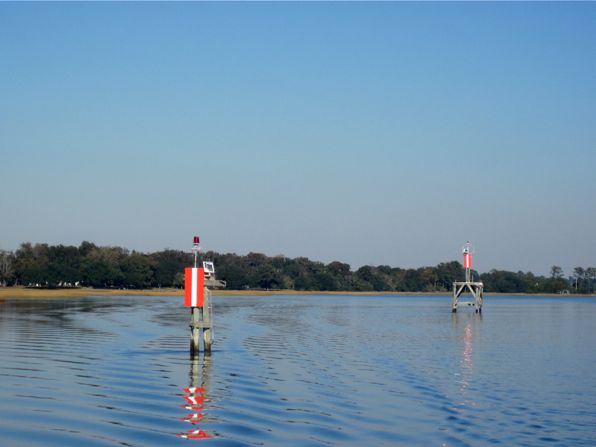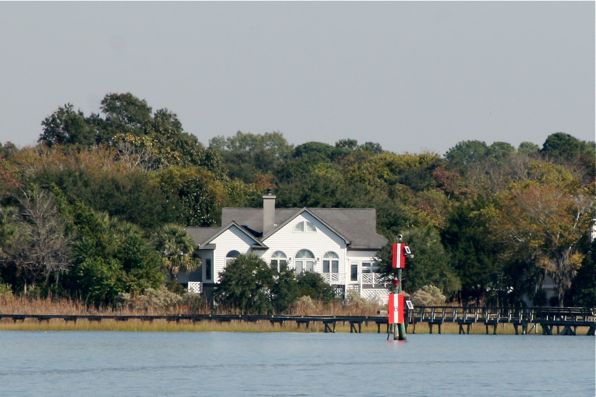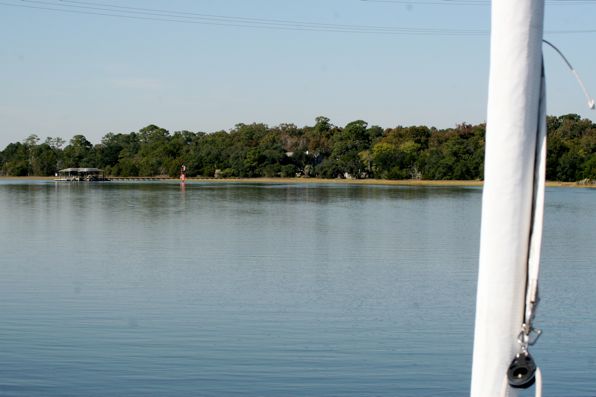No cutting corners
Everyone is no doubt familiar with the admonition about not “cutting corners.” No where is that more true in a literal sense than when navigating some of the shallow areas of the Intra-Coastal Waterway. The red and green lateral aides are (hopefully) laid out in such a way that if they are followed properly, running aground should not occur. But what is properly?
Rebecca and I recently watched a video on the ICW and it suggested that we run the marks as a barge would, as opposed to zig-zagging directly from mark to mark. Good advice I think. It’s also important to not let the wide expanses of water beside you lull you into a sense of overconfidence. I only just now finished my shift at the helm, navigating us through the Dawho River in SC. Although the river may be wide in parts, the water is very “skinny” outside the channel, especially at low tide as it is now (there is about a 7 foot tide swing here).
In addition to the more common red and green lateral aides, we have also come across more and more “ranges” in the last couple of days. For those not familiar with ranges, these pairs of marks are arranged to help mariners stay within a narrow channel. The various photos below show it quite clearly but the basic idea is to line up the closer, lower mark with the further, higher one. When they are lined up, your vessel should be in the channel. When they are out of alignment, you know that you need to make a course adjustment either to starboard or port. This is definitely more easily done while traveling towards the range but just as often, you could be moving away from it, requiring that you continually check over your shoulder to ensure that you are on course. Back in December 2008, when we did our Fast Track to Cruising Course, Capt. Mike, our instructor, referred to this action as “bobble-head, ” like the dolls. It’s funny what things stick in your mind.

Our anchorage in Charleston was right by the range markers.

Rear range marker with us very far to port (or starboard if we had been going towards the range).

This shows both range marks, with us again, very far to port (we are moving away from the range).

We are again quite far to port (moving away from range).

The same two marks now in alignment, indicating that we are in the recommended channel.

What range marks can look like from a distance.

Too far to starboard (heading towards the range)

In the channel.

Too far to port (heading towards the range)


Mike – Thanks! For one I really appreciate the nitty gritty details.
You’re welcome Jim.
Nice job! Very, illustrative!
Fair Winds,
Mike
Thanks Mike. Our shallow draft allowed us to, for the most part, ignore the ranges yesterday although I did follow one pretty accurately during today’s travels.
Great photos to illustrate your subject!
What does one do to stay in the channel when you are between markers, though?
You mean when there are no range markers? Lateral buoys, red nuns and green cans, define the outer edges of deep(er) water. Ranges aren’t really all that common when compared to these. Ranges are used only when very narrow channels need to be followed.
No, what I meant was… I presume you are either sailing towards or away from the markers that you line up. If you’re sailing towards them and get past the first one, then you are between them and have nothing to line up anymore so how do you stay in the channel? Or am I totally not understanding how they work?
No, you understand. Sometimes both marks are on land so you wouldn’t be able to sail past it. If in the water, the channel would typically turn before you passed (HIT!) the closer mark. The intended usable area of a range is shown on a navigation chart as a dotted line.
The trick is to look ahead to the next buoy but not point right at it. That’ll just bounce you from buoy to buoy, lowering your speed of advance and potentially standing your vessel into danger. If you’re in a red-right-returning area (which isn’t always the case in the ICW…the buoys switch in places) and you’re heading into port, and the next buoy ahead is a green, don’t point right at it. Instead, steer a degree or so to right of the buoy. Look past it to the next one and steer to the right of that one too (if it’s green…left if red; a lot of times it’ll be green, green, then green red or something similar) and you’re all set. You’ll roll straight down the channel without bouncing between the buoys. Ideally, the red buoys and green buoys should be equidistant as they pass abeam of your vessel. After all Center of Channel is the place to be. 🙂 This of course assumes a straight buoy chain. A curved course laid out by buoys can be more challenging, but the same principal applies. Remember, in addition to being aids, buoys are also HAZARDS to navigation. You never want to point right at a hazard, right?
In all cases, do NOT trust GPS alone. Study the charts hard and use your eyes (and binoculars) to identify the markers 2 or 3 buoys ahead of you in the channel. They’ll line up like lane markers on the road if you’re within the channel Anticipate where you’ll be early on. And you’ll be ok.
Also, look astern a lot. Just as the buoys ahead will resemble lanes on the road, so will the buoys astern.
If you ever see the buoys in a line, one behind the next behind the next, you’re about the exit the channel. Turn. Turn now. Toward the center of the channel.
One other thing. Make sure you’re taking sightings from a good reference point. During my ICW voyage, I got quite frustrated with Paul, the guy who made the trip with me, during our transit of the Currituck Sound. The channel there is dredged to about 14 feet at center, but runs about 7 feet at the edge. Past the edge, there are a lot of submerged piles not far from the channel and it shoals to less than 5 feet rather quickly. We drew 4.5 ft, so I couldn’t understand why he would keep steering to the left of the green buoys. We kept exiting the channel and I had to forcefully tell him to turn right to get us back in. The transit took a couple hours, and I began to steam. Whenever I asked him why he was steering to the left of the buoys, he replied that he wasn’t: he was steering right of them. How? He’s a very experienced and competent sailor. What’s the deal? Then, after about an hour, it hit me. My boat doesn’t have a seat behind the wheel, and he didn’t feel like standing all day. So he put a bucket on the port cockpit bench and sat up on it. That way, he could see over the cabin as he steered. The problem was, that offset him about 3 feet from the boat’s centerline and he was steering suing the forestay as a reference. On a 28 foot boat, those three feet equates to about a 10 degree offset in the viewing angle, compared with looking straight down the centerline. So if he pointed the forestay just to the right of the buoys from his perspective, he was really steering the boat a bit to the left of the buoys. He needed to take that into account as he was steering, but didn’t until I pointed the problem out. Small errors like that can kill you if you’re not careful.
Wow, that was a novel. Sorry about that. 🙂
Your “novel” is full of good info. Thanks for taking the time to post Alexei!
Range marks have always made me wish for a rear view mirror on my boat! In variably, as I turn to check the range, I shift the tiller, which moves me off the range! Our range in the Sandusky Bay is for commercial ships. With my 3’2″ deraft, I don’t necessarily need to follow them strictly. However, it is better to do so, unless a laker is bearing down on you. In that case, you MOVE OVER, since they move a lot faster than they seem to do!
Yes, as you could see in those pics, we weren’t really all that concerned about staying in the channel either, but it is good practice to try sometimes.
Hi, good pics of some nice, visible ranges. Never heard them called that though – must be an American thing along with having the buoyage the wrong way round. We call them ‘transits’, and very useful they are.
It can be useful to make your own sometimes, especially if you can’t see the next bouy, or even if you’re sick of looking backwards. When you know you’re on the course and that tree lines up with the roofline just right – well that works too. Just don’t use a car some b—r could drive away!
Thanks for the tip. I have also heard them referred to as transits.